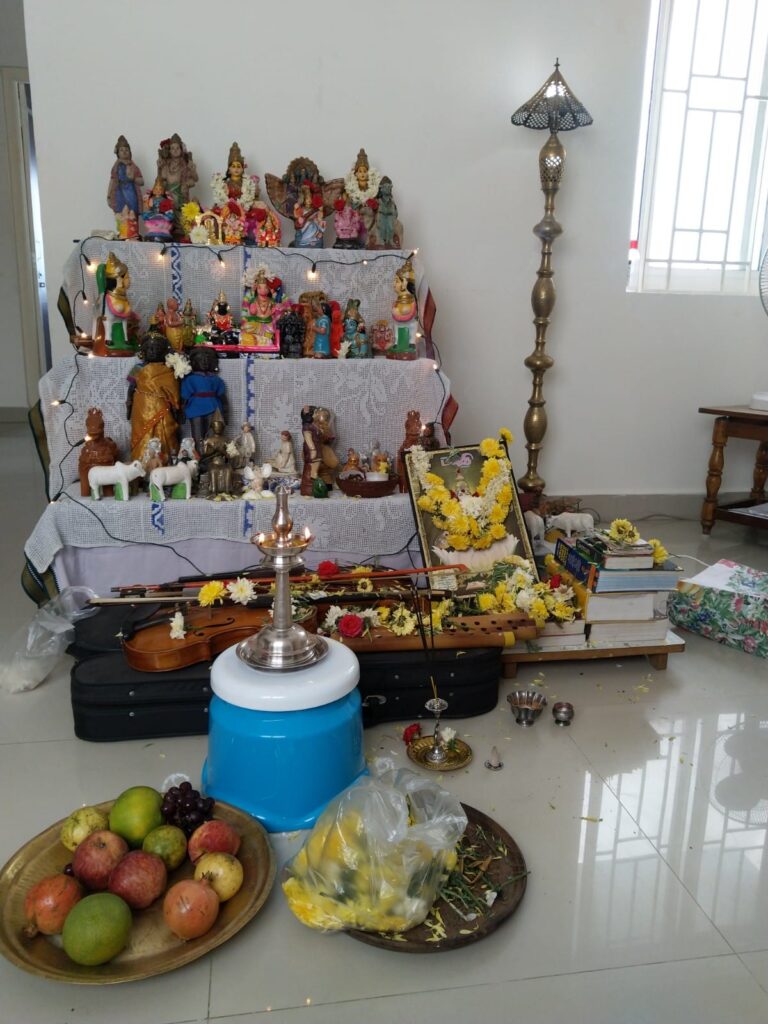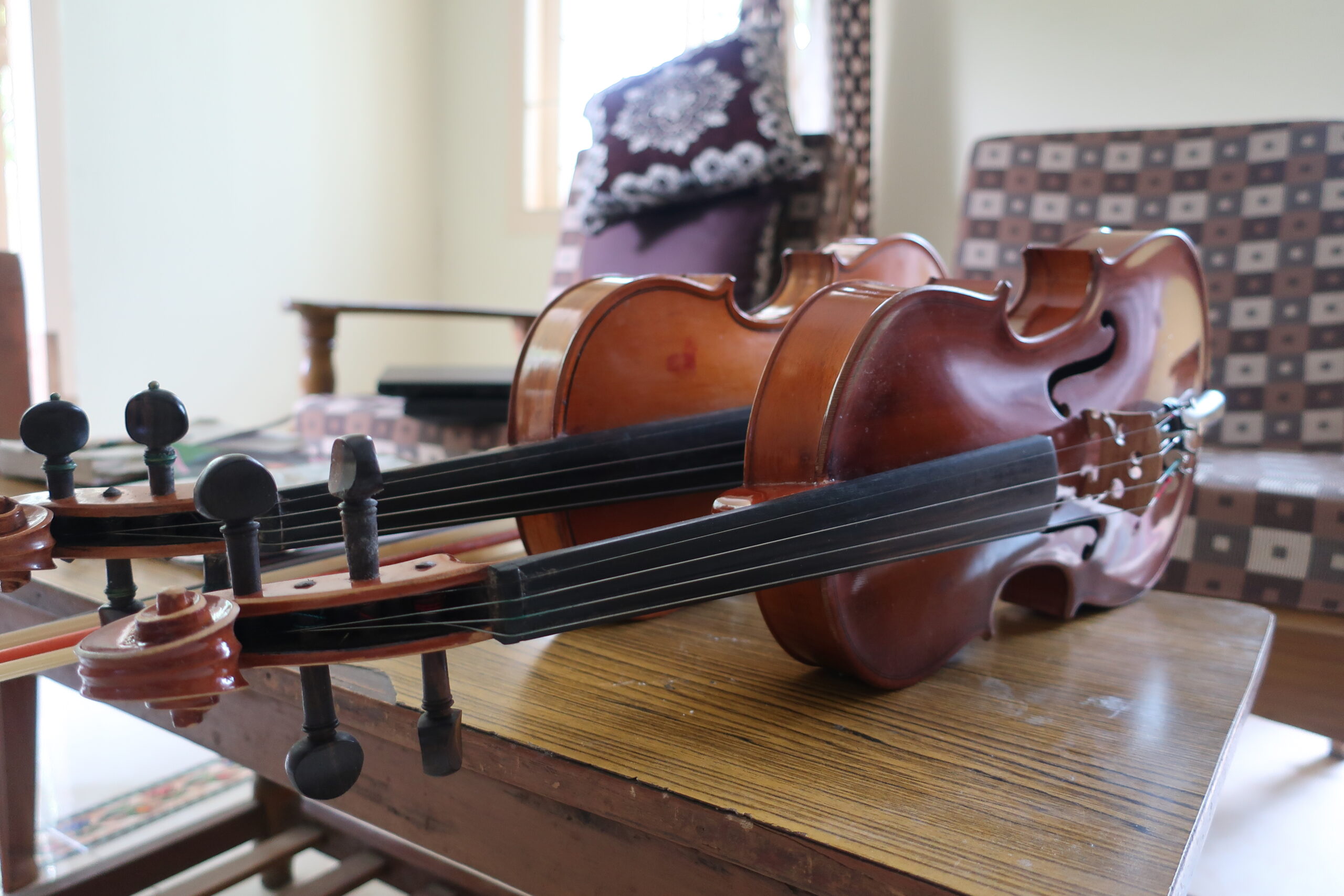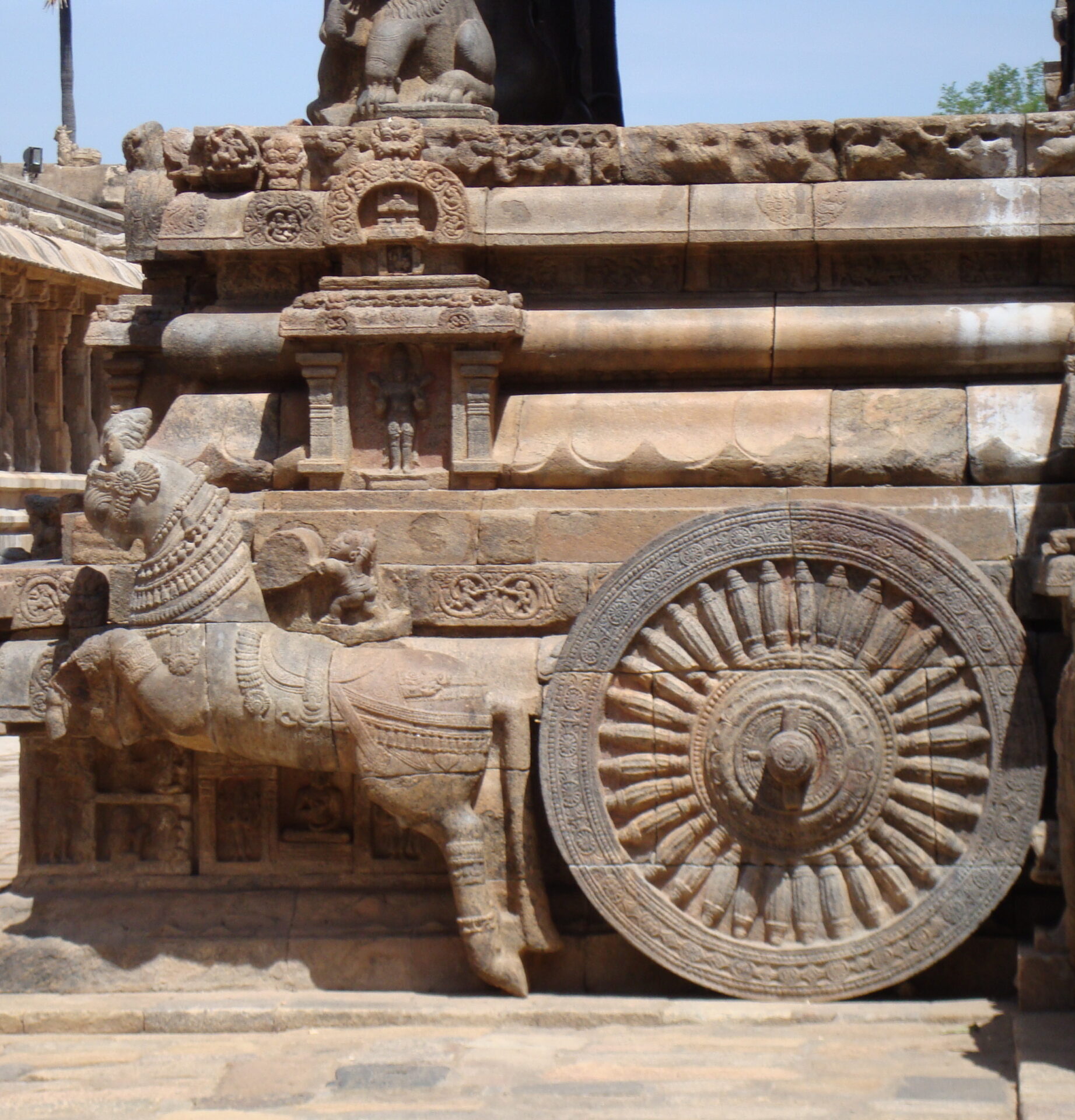Navarāthri, meaning `nine nights’ in Sanskrit, is an autumn festival celebrated every year throughout India and beyond. While it is celebrated in ways throughout the subcontinent, how it is celebrated in Tamil Nadu, in my heavily biased opinion, is objectively better in all ways. Navarāthri brings to the surface memories of school holidays, setting up a display of dolls called Golu, the spiced lentils (sundal) that were handed out in copious amounts whenever someone visited, all the kids gathering around the Golu and the little ones singing, that came across as a cacophony instead something more pleasing, depositing all the textbooks near the Golu on Saraswathi Puja day, so that my parents didn’t make me study for the upcoming Half-yearly exams, and bidding farewell to the dolls that would be seen again only a year later. I distinctly remember setting up a massive display of dolls, with many antique trunks providing the dolls necessary for it. Some dolls were heavier than me, and some, older. As each one of my own chartered their paths in life, the display became smaller, more modest and more reserved.

While the festival is celebrated for different reasons in various parts of India, it is reserved for the worship of Goddess Pārvati. While the fiercer forms of the goddess are worshipped elsewhere, in the south, the festival implies the celebration of her calmer forms. From where I am from, worship took a back seat. Relishing the company, the food and music were of importance. I am never home during this holiday, but I do try to keep the spirit of this holiday alive (after clocking in my 9-5) in the evenings with music. This time, it certainly is not discordant noises from uncracked voices, but soothing music from YouTube! While I don’t try to make my `music-listening’ thematic, I have made an exception this time and drawn up a list of carnātic pieces that emphasises the beauty and eminence of the goddess. This article is quite long. I would ask you to grab yourself a cup of tea a few biscuits.
The first song I have on my list is Kamalāmbha Bhajare from Shri Muthuswāmi Dīkshidhar set in Kalyāni rāgam. Regarded as one of the musical trinities of Carnātic music, he composed 11 pieces of music which extolled the beauty of Kamalāmbha, the reigning deity of Tiruvārūr Thyāgarāja temple, called Navāvarna kīrthis. That all the pieces in this set of kīrthis begin with the declension of `Kamalāmbha’ is interesting. Back to the song, I find this music particularly pleasing, in part due to the rāgam it is set in, but also in part due to its meaning. He describes the goddess in exquisite detail and provides us a picture of how he viewed the goddess. He starts by describing who attends to her (kamalāvāni sevithā), Lakshmi and Saraswathi themselves! Here, he establishes Pārvathi’s dominance. This imagery is not controversial. In Lalithā Sahasranāmam, the magnum opus from Bhramānda Purānam which provides 1000 names for Tripurasundari, Hayagrīva provides a name `sachamara ramā vani’, meaning the one who is attended to by Vāni and Ramā. He describes her tenderness by her bearing a soft voice (mrudu gadanām), having splendid teeth (kamanīya radanām) and as one who possesses a lotus-like face (kamala vadanām). Immediately after, he emphasises the dichotomy of her character by describing her more fierce side by reminding us about her slaying Bhandāsura (garvita bhandāsura bhanjanīm). He ends the song by describing her as one who assumes the form of the universe (urvī tatvādi swaroopinīm). The immortal M. S. Subbulakshmi provides voice to this music and I implore everyone to listen to it here!
The second song on my list is set in the haunting rāga Amruthavarshini, Sudhamāyi Sudhanidhi, composed by Muthiah Bhāgavadhar. Born in Tirunelvelī (my grandfather’s native place!), he is credited to creating around 20 new rāgas, adopting many hindustāni ones into carnātic music and composing over 400 songs. He was a court musician to Seithur Zamin, which was ruled by Seithur Sevugapāndiya Thevar, who ruled over around 50 sq. km. of land, at its peak. On a tangent, Thevar might have been a ruler to a piece of clay barely larger than a modern Special Economic Zone, but he sure was a patron of arts and a polyglot! Bhāgavadhar was also the first guru to M. S. S! Talk about leaving a legacy. In the song he composed, he describes the goddess as one who is a repository (sudhā nidhi) and pervaded by (sudhāmayi) nectar. He then conjures up the imagery of Kāmakshi by the verse `cārekshu kodhande’, the one who wields sugarcane. Referring to Sahasranāmam, the goddess is referred to by the name `manorūpekshukodhandā’ (one who wields a bow of sugarcane, which is her mind). He reminds us of her primacy by pointing out that the lord of justice and death, Yamarāja worships her (vidhīndhranutha). She describes her as the one who bewitches the world with her lotus-like eyes (sarasījāksha jaganmohini). He ends the kīrthi by calling her the one who showers nectars of joy (ānandāmrutavarshini). The shower metaphor is perhaps intentional here. The rāga, created by Muthuswami Dīkshithar, is believed to create rain. Listen to this entrancing composition sung by M. L. Vasanthakumari here.
The third song in my list is Akhilāndeshwari Rakshamām, composed by Muthuswami Dīkshithar set in, what I would consider queen of rāgas, Dwijāvanthi. Unlike the previous songs on my list, this piece has been composed with a singular deity in mind, Akhilāndeshwari of Tiruvanaikāval. The diety has been revered since the late Vedic ages. Her name translates to the divine mother (īshwari) who protects the entire (akhila) universe (anda). It is said that the deity was originally a fierce one, one who burned anyone who dared to look at her, let alone approach her. Ādi Śaṅkarācāryaḥ placated her anger by installing a form of her son, Ganapathi in front of her Sanctum Sanctorum and by installing a pair of ear studs (tātanka). Till this day, it is deemed a part of the duty of Kānchi Kāmakoti Pītham, the spiritual successors of Ādi Śaṅkarācāryaḥ, to repair the ear studs, if such a need arises. In this song, Dīkshithar describes her as the one adept at āgamas (āgamasampradāya nipune) and requests her to protect him, just like she protects the universe. He goes on to describe her sweet, sublime nature to be pervading throughout the universe (nikilaloka nithyāthmike). The dark one (shyāmale) is described as someone adept at all forms of art (sakalakale). She is worshipped by her sons (lambodhara guruguha pūjithe) and Vāni (vāgdhevathāradhithe). He ends the composition by stating that she is pleased by the sound made by various instruments (jhalli jharjara maththala vādya mudhite) and who loves the rāga Dwijāvanthi (jujāwanthi rāganuthe). Allow me to please you by redirecting you to the song performed by Trichur Brothers here!
My next two songs are about the goddess of knowledge and the goddess of wealth. G. N. Balasubhramanyam composed the song Saraswathi Namosthuthe, in praise of Saraswathi in Saraswathi rāgam! While being part of the triad of goddesses (tridevi), Saraswathi has always been depicted in a more docile and gentle role. Despite being part of the trinity, Saraswathi conspicuously lacks many temples where she is venerated. There is only one temple dedicated to her in TamilNādu, in a nondescript village called Koothanūr. As kids growing up in the south, the day of Saraswathi puja, a day earmarked towards her worship, is invariably our first school day, a day when we start our formal education. Coming back to the song, G. N. B. describes the goddess as the grantor of all knowledge (vidhyāpradhe), as the one who, in her many hands wields a book and the veena (karadrutha veenapusthaka), as the one is served by the divine devas (surasevitha padhayugale) and whose brilliance matches that of the sun god (sudhākara samagavale). Listen to this song rendered by the Ranjani-Gayathri duo here.
On to the next song about Mahālakshmi – Ksheerabdi Kanyakaku, composed by Annamācharya in Kuruji rāgam. This song belongs to the category of `neerājanam’ (benediction). Annamācharya was the divine poet who make Tirumalā his home and almost exclusively composed songs that sang praises of Vishnu. Annamācharya, along with Pey Azhwar are considered to be incarnations (avatāras) of Nandakā, the sword of Vishnu. Despite being born in the Smārtha tradition, Annamācharya nowadays is more associated with the Vaishnavā tradition. In this song, Annamācharya describes Mahālakshmi as the daughter of the ocean of milk (ksheerābdi kanyakaku), a direct reference to Bhāgavata Purāna, where Lakshmi emerged from the milky ocean when it was churned (ksheerasāgaramantham) and as the one who resides on a lotus flower (neerajālayaku). He goes on to describe her as the lotus-eyed one (jalajākshi), as the one who holds a lotus flower in her hand (hastakamalambulaku) and as the one who stands tall with gleaming emeralds (niluvumānikyamulu). Annamācharya goes on to use a plant-based metaphor describing the goddess’s feet (charanu) as sprouts (kisalayamulaku) and a plantain tree (sakhiyarambhorulaku). Plantain tree is an auspicious symbol and is found wherever happiness has taken refuge. He describes her as Vishnu’s queen (sreevenkatesu pattapūrāniyai) and ends the composition by praying for an ever pervading auspicious light (shobanapu nīranjanam). Of course, I will redirect you to the song sung by M. S. S here. As inextricable as milk and honey, so are Annamācharya krithīs and M. S. S!
The next two songs in the list are composed in the classical language of Tamil. The sixth in my list is a song composed by the short and heavily built sage, Agastyā – Shrī Chakra Rāja Simhāsaneshwari. Agastyā has been mentioned in all four Vedās, in Ramāyana and Mahābhārathā and numerous purānic literature. He is considered the father of Tamil grammar, credited to being the author of Agathiyam, a treatise on Tamil grammar. In Tamil traditions, he is considered the first among equals among the Siddhars (a perfect individual). According to Bhramāndapurānam, Lalithā Sahasranāmam is a result of the interaction between Hayagrīvā and himself. So, it is not surprising that he would compose a song in Tamil about the goddess. As opposed to the other songs in this list, the song has been composed in the first person and reads like a monologue. The song is set in Rāgamālika, a collection of many rāgas. He starts by describing the goddess as the one who sits on the divine throne of Srī chakra (shrichakrarāja simhāsaneshwari), the personification of agamās, vedās and art (agamaveda kalāmaya rūpini), the serpent-bangle adoring consort of the dancing king (nāgakankana natarājamanohari) and the empress of all emperors (rājarājeshwari). Till this point, all he does is describe the goddess. It wouldn’t be amiss at all if one mistook the song to be composed in Sanskrit. Hereon, the charanams have been written in Tamil. He asks for stability (orunilai) so that he can dance and sing praises to her. He goes on to say that she made him a noble soul (uththaman), who was a wanderer (uzhanthuthirintha), and placed him in the company of the learned (uyariyaperiyor). He concludes by declaring that she gave a purpose to his birth (piranthapayan) and declares that he takes refuge in her (adaikalamnīyeamma), the protector of the universe, Akhīlāndeshwari. The four ragās amalgamate so gracefully with the lyrics, which illustrates not only the sage’s humility but also his knowledge in music. Maharājapuram Santhānam provides his regal voice to this composition here. This is certainly a ‘must listen to’ for anyone out there.
The seventh song on my list, Yādhumāgi nindrai, set in Pūrvi Kalyāni, is from someone whose works are close to my heart, Mahākavi Bhārathi. His penury did not prevent him from composing powerful poems in his short life span of 38 years. It is said that he would borrow food grains from his neighbour for his family’s next meal, and instead of cooking it, he would throw the grains to the sparrows and burst into euphoria on seeing their happiness. Sometimes, the maker does break the mould once he created a character. He wrote about the independence movement, societal reform and spiritual themes. He likened Krishnā to be his friend, his mother, his servant, his king, his child and his lover, to name a few. He pondered on the meaning of life and about the universe in his poem – nirpathuve nadapathuve. If you’d read the poen, you’d be convinced that he could perhaps been the first person to put forward the simulation hypothesis! I could write multiple posts about this modern sage, but that’s for another day. In the song Yādhumāgi nindrai, he starts by describing Kāli as the personification of everything (yādhumāgin nindrai), that she is everything good and bad (theethunanmai), that she is all five great elements (panchamahābhūtā) through the verse ‘bhūthamainthumānai’ and that she stood as the conscience within him (bodhamāgi nindrāi). He goes on to claim that she is residing within him as pure bliss (imbamāgi vittāi) and that he cannot sustain without her (pirithu nānum undo). He finished the composition by saying that she filled him with love (anbu) and virility/courage (ānmai) and that she removed his sorrows (thunbam) and vanquished all his problems (thollai). Kāli is the fiercer form of the goddess. Bhārathi somehow manages to never bring out the fierceness of the form, instead makes us look at her more compassionate side. The song is usually sung very slow and makes one ponder about it while listening to it. You can listen to the song being sung by Sudhā Raghunāthan here.
The eighth song on my list is Pāhimām Shrī Rājarājeshwari, set in Janaranjani, composed by Mahā Vaidyanathā Sivan. Born in the quaint village of Viyacheri in Thanjāvur, Vaidyanathā Sivan is credited to composing a Rāgamālika (a composition with many rāgas) with 72 mela rāgas! It is said that he accomplished composing the song in one week and was rewarded with 2000 rupees, a massive sum back in the 1800s. In this song, he asks the wife of shankarā (shankarī), the one who performs merciful acts (krupākari) to protect him (pāhimām). He asks the one who rides a lion (simhavāhini) that he be granted unmatched happiness (ehi sukham dehi). He goes on to remind that despite her merciful nature, she was the one who vanquished the demons bhandā, chandā, mundā and mahishā. He ends the song by describing her as the flawless one (niranjani), the nourishing one (phoshani), the one with a sweet voice (subhāshini) and the grantor of all boons (vara bhūshani). On the whole, the composition is a very soothing one, with the choice of rāga being very apt, in my very amateur opinion. You can listen to the song here, sung by the Priya sisters.
The final song on my list is Ānandavalli set in Nīlāmbhari, composed by the erstwhile King of Travancore, Swāthi Tirunāl. He was a prolific composer, having over 300 compositions attributed to him, a polyglot who spoke more than 8 languages, a patron of arts and an able administrator. He was a ruler with mettle, who put up a strong resistance against the malicious Victorian machination to usurp the kingdom and strip it away of its sovereignty. I chose this song in part due to its rāga, but also because of its very vivid description. I couldn’t do any justice to the song if I only translated what I felt were interesting bits. The whole song is an art beyond comparison. Nīlāmbhari is also a very soothing raga, something that belongs in a lullaby and is associated with peace, tranquillity and unbridled joy. True to the rāga the song is set in, the Rāja begins the song by asking Ānandavalli to grant him eternal happiness (kuru mudama viratam). He continues by saying that her smile alone eradicates (kiranāyita) the sorrow and grief (santāpa) of commoners (dīnajana) and that she wields a young (potha) parrot (shukha). He goes on to describe her as the daughter of the king of mountains (girirājasuthe), the one who is like a bee (madhūpe) swarming around the lotus face (sarasīruha) of Shivā (shambuvadana). He describes her as the one who resides in the heart of ascetics (munihhrudaya nivāsini) and ends the composition by asking her to dispel (hara) his grief (shukam). It is not often that you get to listen to this song being performed in concerts. I will never know the reason why. I don’t ever recall listening to this song in any of the concerts I’ve been in. Nevertheless, listen to this song being performed by Sanjay Subramaniam here. Let there be Ānandā (joy)!
I hope that your cup of tea has long since been drunk and your plate of biscuits empty, and you enjoyed this list of my personal favourites for this festival season. It is statistically impossible for two carnātic music lovers to draw up the same list. But I sure do hope that, if, for some reason, you haven’t come across the songs in this list, that you do listen to it at least once. Au revoir!

